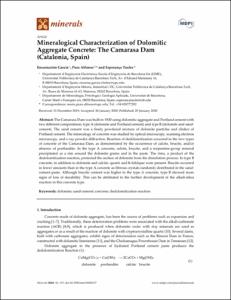Mostra el registre d'ítem simple
Mineralogical characterization of dolomitic aggregate concrete: the Camarasa Dam (Catalonia, Spain)
| dc.contributor.author | García Vílchez, Encarnación |
| dc.contributor.author | Alfonso Abella, María Pura |
| dc.contributor.author | Tauler Ferré, Esperança |
| dc.contributor.other | Universitat Politècnica de Catalunya. Departament d'Enginyeria Electrònica |
| dc.contributor.other | Universitat Politècnica de Catalunya. Departament d'Enginyeria Minera, Industrial i TIC |
| dc.coverage.spatial | east=0.8567905000000001; north=41.9350644; name=LV-9043, 6, 25612, Lleida, Espanya |
| dc.date.accessioned | 2020-03-06T08:38:06Z |
| dc.date.available | 2020-03-06T08:38:06Z |
| dc.date.issued | 2020 |
| dc.identifier.citation | Garcia, E.; Alfonso, P.; Tauler, E. Mineralogical characterization of dolomitic aggregate concrete: the Camarasa Dam (Catalonia, Spain). "Minerals", 2020, vol. 10, núm. 117, p. 1-13. |
| dc.identifier.issn | 2075-163X |
| dc.identifier.uri | http://hdl.handle.net/2117/179327 |
| dc.description.abstract | The Camarasa Dam was built in 1920 using dolomitic aggregate and Portland cement with two different compositions: type A (dolomite and Portland cement) and type B (dolomite and sand-cement). The sand cement was a finely powdered mixture of dolomite particles and clinker of Portland cement. The mineralogy of concrete was studied by optical microscopy, scanning electron microscopy, and x-ray powder diffraction. Reaction of dedolomitization occurred in the two types of concrete of the Camarasa Dam, as demonstrated by the occurrence of calcite, brucite, and/or absence of portlandite. In the type A concrete, calcite, brucite, and a serpentine-group mineral precipitated as a rim around the dolomite grains and in the paste. The rims, a product of the dedolomitization reaction, protected the surface of dolomite from the dissolution process. In type B concrete, in addition to dolomite and calcite, quartz and K-feldspar were present. Brucite occurred in lower amounts than in the type A concrete as fibrous crystals randomly distributed in the sand-cement paste. Although brucite content was higher in the type A concrete, type B showed more signs of loss of durability. This can be attributed to the further development of the alkali-silica reaction in this concrete type. |
| dc.format.extent | 13 p. |
| dc.language.iso | eng |
| dc.rights | Attribution-NonCommercial-NoDerivs 3.0 Spain |
| dc.rights | CC BY 4.0 |
| dc.rights.uri | http://creativecommons.org/licenses/by-nc-nd/3.0/es/ |
| dc.subject | Àrees temàtiques de la UPC::Enginyeria dels materials |
| dc.subject.lcsh | Mineralogy |
| dc.subject.lcsh | Concrete |
| dc.subject.other | Dolomite |
| dc.subject.other | Sand-cement |
| dc.subject.other | Concrete |
| dc.subject.other | Dedolomitization reaction |
| dc.title | Mineralogical characterization of dolomitic aggregate concrete: the Camarasa Dam (Catalonia, Spain) |
| dc.type | Article |
| dc.subject.lemac | Mineralogia |
| dc.subject.lemac | Formigó |
| dc.identifier.doi | 10.3390/min10020117 |
| dc.description.peerreviewed | Peer Reviewed |
| dc.relation.publisherversion | https://www.mdpi.com/2075-163X/10/2/117 |
| dc.rights.access | Open Access |
| local.identifier.drac | 26806059 |
| dc.description.version | Postprint (published version) |
| local.citation.author | Garcia, E.; Alfonso, P.; Tauler, E. |
| local.citation.publicationName | Minerals |
| local.citation.volume | 10 |
| local.citation.number | 117 |
| local.citation.startingPage | 1 |
| local.citation.endingPage | 13 |
Fitxers d'aquest items
Aquest ítem apareix a les col·leccions següents
-
Articles de revista [353]
-
Articles de revista [1.728]


